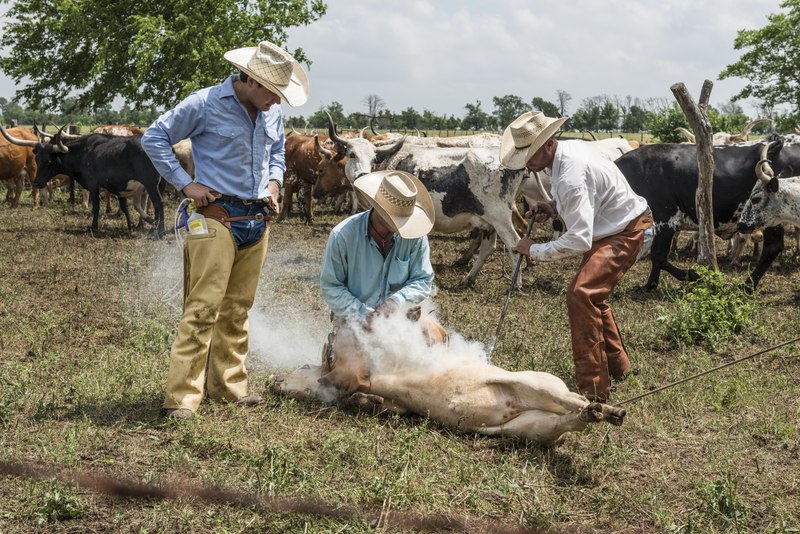Every 10 years, ranchers in Texas must register their livestock brand with the local county clerk. The reregistration period is happening now. Clerks around the state register the thousands of unique brands that ranchers use to distinguish their cattle from everyone else’s.
The practice hasn’t changed much since the early days of the cattle business. Delbert Trew is a rancher, writer, and historian from McLean. He spoke to the Texas Standard about the history (and future) of brands. Listen to the interview above or read the transcript below.
This transcript has been edited lightly for clarity:
Texas Standard: Tell us a little bit about the origins of branding in Texas as you understand it. This has been done since before Texas was even its own republic.
Delbert Trew: It actually came about as Christopher Columbus brought cattle to the New World, and they eventually moved over into old Mexico and from old Mexico. It moved both north and south in the New America. And of course, they brought the livestock. As they increased, they had to be marked some way for identity.
And some of those marks are really old. I think a lot of Texans may know the Running W. You’ve probably seen that one
That’s probably the most famous Texas brand in the southern part of Texas on the coast. There are several other brands in the middle of Texas, of course, pretty well dominated by the 6666 brand. And then in the northwest part of Texas, out in my country, the most famous brand was the XIT.
These all have great stories attached to them as well. The Running W is the King Ranch down in South Texas The XIT has some kind of University of Texas connection, as I recall.
Well, the land was traded to the construction company to build the Texas Capitol. In exchange – the XIT was all open range at that time, owned by Texas government, – they traded that to the construction company that built the Capitol.
You’ve got these winged brands, you’ve got tilted brands, lazy this and that, and the other. Who comes up with these designs?
Well, a brand can be one digit, two digits or more, and it can be letters, numerals, it can be symbols. Common sense says keep it simple – quick to apply, easy to read, and with less pain to the animal.
I know that there have been some technological developments. Would it be easier to say, put a chip in an animal, the way you might a domestic animal?
Well, probably the biggest use other than cattle brands today is deer tags. And you’ve got chips in them. So there’s all kinds of ways. And even if you put a chip under the hide, it’s still hard to detect on the surface. You need some kind of a mark And even if you have a reader and you’re reading that chip, you’d have to get pretty close to it and study it a little bit to recognize the individual.
What about the practice of branding? I understand it’s rather tricky. Is there a secret to getting a clean, recognizable brand without inflicting too much pain on the animal?
Well, there’s a lot of factors involved – whether it’s summer with short hair, winter with long hair, whether it’s after a dirt storm with hair full of dust. And of course, the heat of the iron. If it’s too hot, it’ll set the hair on fire and blot the brand. If it’s too cold, then it won’t make a good brand. But if it’s just right, it’ll leave a good clean brand that heals quickly and causes very little pain to the animal,
Do you hear much talk about whether or not brands are still relevant? Or is it just assumed that branding is going to be with us for good?
Well, for one thing it’s going to be awfully hard to abandon tradition because there’s nothing as relevant as a rancher pointing to an animal with his brand on it, it’s a pride thing. It’s respect for the industry. But they’ll probably never get rid of branding on mother cows out on the range. Once cattle are brought into the ranks and to the feedlot and are moved on to the final process, I think these newer kinds of identification will be more prominent.
Mr. Trew, do you have a brand?
Yes. Our ranch goes back to 1896, when Alfred Rowe established the famous RO ranches here. And of course, he died on the Titanic, which was very interesting. And then the next man came along and owned our country, had a brand called the Hip-O, which was simply an O branded on the left hip.
When my dad purchased the property, he had a brand called Bar-T-Bar. But when we come down here, we couldn’t use that. So he had to adopt another brand. So we used the Spanish gourd, which looks kind of like a bell. And then, as I come in to being, my brand is a stirrup, like a stirrup on a saddle.













